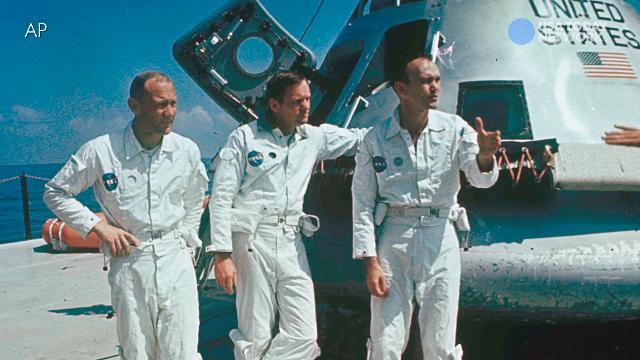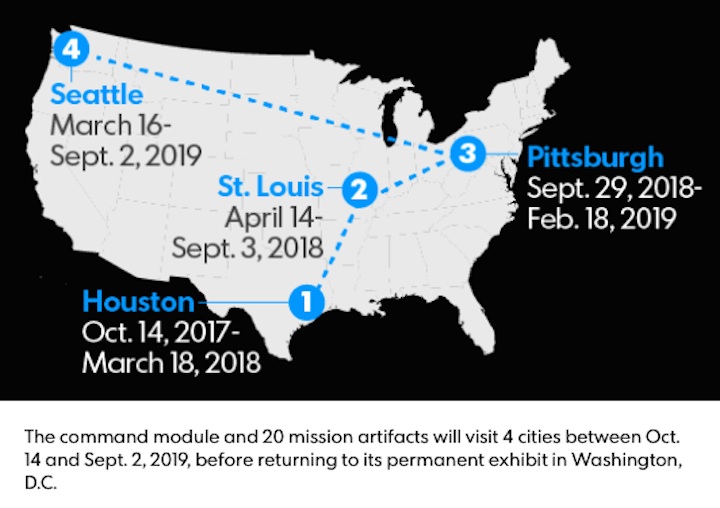23.02.2017

The Apollo 11 command module Columbia will temporarily leave the Smithsonian for the first time in 46 years to begin a journey to museums across the country. Jack Gruber
CHANTILLY, Va. — One of the most iconic objects in human history — the spacecraft that carried the first men to the moon in 1969 — is going on a road trip.
The command module Columbia will star in a two-year, national tour called "Destination Moon: The Apollo 11 Mission," celebrating the 50th anniversary of the historic voyage.
"It represents one of the great achievements of mankind," said Myriam Springuel, the director of the Smithsonian Institution Traveling Exhibition Service that runs the tour. "We are privileged to take it across the country and to share it with the people who own this object, which are the citizens of the United States."
The module was the main living area for the three-man crew of astronauts Michael Collins, Buzz Aldrin and Neil Armstrong that took them on the nearly 1 million mile journey to the moon and back. It's the only part of the spacecraft that returned to Earth.
The last time the capsule left the Washington area was for a national tour in the early 1970s. It's been on display at the National Air and Space Museum for most of the past 40 years.
"Apollo is such an amazing story and we hope to relight that inspiration in America today," Gen. John Dailey, director of the National Air and Space Museum, said at the National Air and Space Museum's Steven F. Udvar-Hazy Center on Wednesday. "We could use that in this country right now, that spirit."
The tour will stop at four museums in Houston, St. Louis, Pittsburgh and Seattle. The exhibition will be on display at Seattle's Museum of Flight on the 50th anniversary of its return to Earth — July 20, 2019.
"People in those areas can get up close and personal with this unbelievable artifact," said David Skorton, secretary of the Smithsonian Institution.
Just like giant panda Bao Bao earlier this week, the capsule will be shipped via FedEx, the sole transportation sponsor of the exhibit.
About 20 other objects from the Apollo 11 mission will travel with the capsule, including gloves and a visor Aldrin wore on the moon, a star chart used on board the lunar module and a "rock box" that brought back the first samples from the moon's surface.
Visitors to the exhibition will also be able explore an interactive, 3D tour showing the inside and outside of the capsule. Visitors aren't allowed inside the capsule, but the interactive will let them view the famous graffiti Collins scribbled after the mission: "The Best Ship to Come Down the Line ... God Bless Her."
---
DESTINATION MOON
The Smithsonian’s National Air and Space Museum has announced a two-year national tour of artifacts from the Apollo 11 moon landing mission leading up to the 50th anniversary of the historic moon landing.



Quelle. USA TODAY
---
It’s official: Apollo 11 moon ship will land in Seattle in 2019, 50 years after giant leap

The Smithsonian Institution has officially put Seattle’s Museum of Flight on the schedule for an exhibit featuring Apollo 11’s moon ship during the 50th anniversary of the historic mission.
Seattle is the last stop on the four-city, two-year tour for the exhibition, titled “Destination Moon: The Apollo 11 Mission.”
Houston, St. Louis and Pittsburgh may get earlier looks at the 20 or so artifacts from humanity’s first moon landing, but the good stuff will all be in Seattle on July 20, 2019, exactly 50 years after that landing.
“It’s going to be incredibly exciting to be in Seattle and looking back at the 50th anniversary, but also looking forward and celebrating everything that’s happening in spaceflight today,” said Kathrin Halpern, project director for the Smithsonian Institution Traveling Exhibition Service, or SITES.
Halpern told GeekWire that teams from SITES and the National Air and Space Museum have been working on “Destination Moon” since mid-2014. The tour takes care of a logistical challenge that was facing the museum in Washington, D.C.: what to do with the Apollo 11 command module during a round of renovation and preparation for a permanent “Destination Moon” exhibit. That exhibit is scheduled to open at the Air and Space Museum in 2020.
Putting Apollo artifacts on the road will ensure that they’re on display during a prime period for celebrating space history.
The command module, christened Columbia, is the craft that carried Apollo 11’s astronauts – commander Neil Armstrong, lunar module pilot Buzz Aldrin and command module pilot Mike Collins – to the moon and back.
Collins stayed aboard Columbia while Armstrong and Aldrin climbed into the lunar module, dubbed Eagle, and went down to the lunar surface. After their excursion, the moonwalkers rode the Eagle back to a rendezvous with Columbia, and then headed back toward Earth.
At the end of the return trip, the Eagle had to be cut loose to burn up during atmospheric re-entry, while Columbia splashed down into the Pacific Ocean. The spacecraft and its astronauts were brought back to shore on the same ship.
NASA put Columbia on the road in 1970 for a 50-state tour, and then it was transferred to the Smithsonian for conservation. It’s been on display at the Smithsonian for decades.
For “Destination Moon,” the module and its hatch will be displayed in separate cases, which should make them all the better to see from different angles.
The exhibit also will present high-resolution virtual views of Columbia that were captured in 3-D scanning sessions a year ago. The scans document the graffiti that astronauts scrawled on the walls – including a makeshift calendar, off-the-cuff calculations and an improvised caution label on a locker that reads “Smelly Waste!”
One of Halpern’s favorite artifacts in the exhibit is the survival kit that the astronauts brought along just in case they ran into trouble after landing back on Earth. “It includes a machete,” she said. (The kit also includes three pairs of sunglasses and two bottles of sunscreen.)
The elements of the exhibit will spend from Oct. 14 to March 18, 2018, at Space Center Houston, which is marking its own 25th anniversary this year. Saint Louis Science Center hosts “Destination Moon” from April 14 to Sept. 3, 2018. The exhibit moves to Pittsburgh’s Senator John Heinz History Center for display between Sept. 29, 2018, and Feb. 18, 2019.
Seattle takes the spotlight starting on March 16, 2019, and will have the exhibit until the following Labor Day weekend. Then Columbia and the other loaned artifacts will go back to the other Washington for installation in the National Air and Space Museum’s permanent exhibit.
The Museum of Flight is no stranger to Apollo-era artifacts: Right now it’s getting ready for its own grand exhibit, “Apollo,” which opens this May 20.
“Apollo” will feature a command module that was used for testing and training, as well as components from the Saturn V rocket engines that lifted Apollo 12 and Apollo 16 off the pad in Florida. The engines fell into the Atlantic after launch, but the mangled parts were recovered from the seafloor three years ago with backing from Jeff Bezos, Amazon’s billionaire founder.
“Right now, the plan is that much of ‘Apollo’ and ‘Destination Moon’ will cohabitate in the same gallery,” Geoff Nunn, the Museum of Flight’s adjunct curator for space history, told GeekWire in an email. The biggest change is that Columbia will replace the Museum of Flight’s command module in the exhibit space, he said. The Smithsonian is also adding Apollo 11 rocket engine components to the traveling exhibit.
Will Bezos add still more to the Seattle show? He and his Blue Origin rocket venture still have to decide what to do with the New Shepard suborbital spaceship that took five flights to space and back in 2015-2016. The now-retired New Shepard is still sitting in Blue Origin’s production facility in Kent, Wash., and Bezos has promised that it’ll go on display at a museum.
Neither Bezos nor museum representatives have tipped their hand. But the fact that Halpern is looking forward to a Seattle celebration of modern-day spaceflight as well as past space glories has to count for something, doesn’t it?
Jeff Bezos and his wife, Mackenzie Bezos, are among the supporters of “Destination Moon,” along with Seattle aerospace executive Joe Clark, the Bruce R. McCaw Family Foundation, the Charles and Lisa Simonyi Fund for Arts and Sciences, John and Susann Norton, and Gregory D. and Jennifer Walston Johnson. FedEx is providing transportation services for the exhibit.
Quelle: GeekWire







